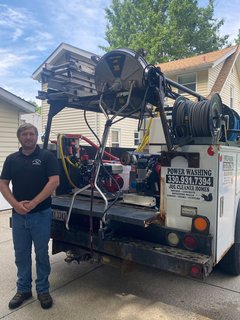The Power of Pressure Washing: A Deep Clean for contemporary Times

Pressure washing, also referred to as power washing, is really a cleaning manner in which uses high-pressure water spray to remove dirt, grime, mold, mildew, and other contaminants from surfaces. From residential driveways to a commercial building and industrial equipment, power washing in stow has become an indispensable tool to maintain cleanliness and visual appeal. This article explores the process of pressure washing, its benefits, applications, as well as the future of this powerful cleaning technique.
The Science Behind Pressure Washing
Pressure washing functions by forcing water via a narrow nozzle at high speeds, starting a powerful jet of water that can dislodge and wash away dirt and debris. The pressure with the water is measured in pounds per sq . inch (PSI) and may vary significantly with respect to the machine and also the task accessible. Common PSI ratings range between 1,300 for light-duty tasks to over 4,000 for heavy-duty industrial cleaning.

There are 2 main kinds of pressure washers:
Electric Pressure Washers: These are typically useful for lighter tasks for example cleaning cars, patios, and small areas. They are quieter, more lightweight, and much easier to maintain.
Gas Pressure Washers: More powerful and ideal for larger, more demanding tasks, gas power washers are commonly used in commercial and industrial settings.
Benefits of Pressure Washing
Efficiency: Pressure washing is really a quick and productive way to clean large areas inside a fraction of times it would take using fliers and business cards. The high-pressure water can reach the nooks and crannies that might be hard to clean manually.
Thorough Cleaning: The strength of high-pressure water can remove deeply embedded dirt, stains, and biological growths like mold and algae, which can be resistant to conventional cleaning techniques.
Versatility: Pressure washing can be utilized on a wide array of surfaces, including concrete, brick, wood, metal, and vinyl. Adjustable pressure settings and other nozzle types permit customized cleaning solutions for several materials and surfaces.
Environmental Friendliness: Pressure washing uses water because the primary soap, often requiring little to no chemical detergents. This makes it an eco-friendly cleaning option, especially when combined with water recycling systems.
Maintenance and Longevity: Regular pressure washing can extend living of surfaces by preventing the buildup of harmful substances that can cause deterioration and damage over time.
Applications of Pressure Washing
Residential Cleaning: Homeowners use pressure washing to wash driveways, sidewalks, decks, fences, and also the exterior of houses. It's an effective way to enhance curb appeal and keep property value.
Commercial Cleaning: Businesses use pressure washing to keep storefronts, parking lots, and building facades and also inviting. It can help maintain a professional appearance and ensures a welcoming environment for purchasers.
Industrial Cleaning: In industrial settings, pressure washing is used to clean heavy machinery, equipment, and facilities. It can help in maintaining operational efficiency and safety by removing hazardous substances.
Graffiti Removal: Pressure washing is an efficient method for removing graffiti from walls along with other surfaces, restoring these phones their original condition with no damage to the underlying material.
Preparation for Painting and Renovation: Before painting or refinishing surfaces, pressure washing is frequently used to make sure the area is free and clean of contaminants that may affect the adhesion and longevity of the new coating.
The Future of Pressure Washing
As technology advances, the stress washing market is likely to see several innovations directed at improving efficiency, reducing environmental impact, and enhancing buyer experience. Some of the anticipated developments include:
Eco-Friendly Solutions: The usage of biodegradable detergents and water-saving technologies will become more prevalent, making pressure washing much more environmentally friendly.
Smart Pressure Washers: Integration of IoT (Internet of products) technology could lead to smart power washers that can adjust settings automatically depending on the surface being cleaned and provide real-time feedback on performance and maintenance needs.
Battery-Powered Models: As battery technologies improve, more powerful and longer-lasting battery-powered pressure washers could become available, offering a quieter and much more convenient option to gas-powered models.
Robotic Power washers: Automation may lead to the development of robotic pressure washers that can clean large areas autonomously, increasing efficiency and reducing labor costs.
Conclusion
Pressure washing can be a powerful and versatile cleaning method that offers numerous benefits for residential, commercial, and industrial applications. Its ability to deliver thorough and efficient cleaning makes it an essential tool in maintaining cleanliness and aesthetic appeal. With ongoing innovations plus a focus on sustainability, the future of pressure washing looks bright, promising sustained efficiency and eco-friendliness within the years to come.
